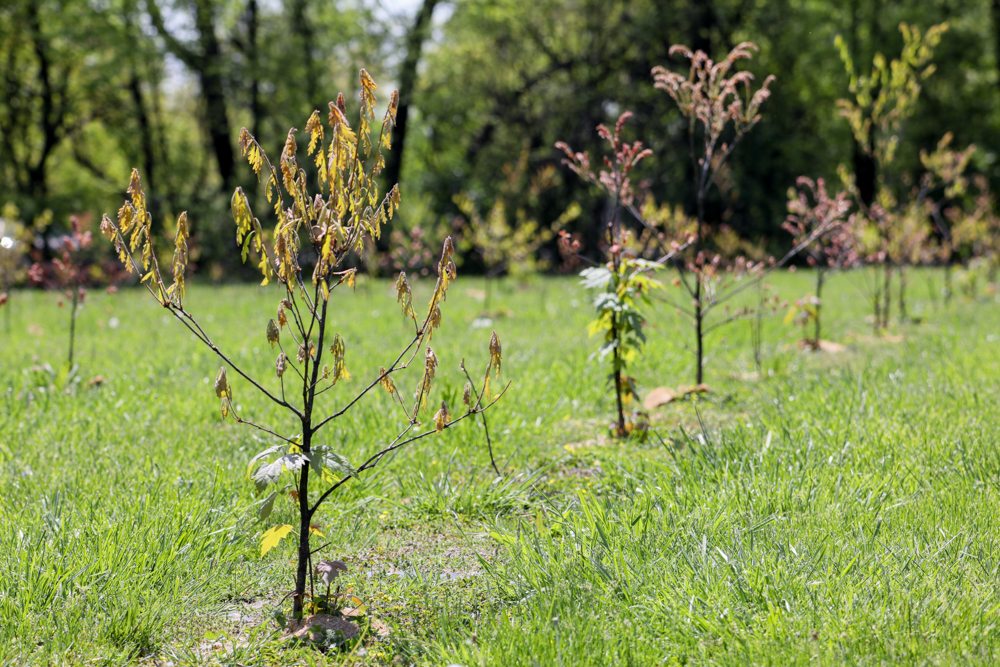
Preserving biodiversity and different nature-related points was not a part of the preliminary sustainability plan at Brown-Forman, the Louisville liquor firm famous for making Jack Daniel’s. Like most corporations, it centered on local weather change, looking for methods to cut back vitality utilization and greenhouse gasoline emissions.
Over time, nonetheless, the corporate added initiatives to protect the well being of the ecosystems that help the bushes and different vegetation important to producing its merchandise. The distinctive taste of Jack Daniel’s, for instance, comes from the sugar maple charcoal used to filter the distilled mash of corn, rye and barley, and to make the charred white oak barrels it’s aged in.
“White oak takes 50 to 70 years to mature, so we would have liked to take a long-term perspective,” defined Andy Battjes, Brown-Forman’s director of world environmental sustainability. “As we have been wanting forward we requested ourselves, Will now we have the agricultural and forestry commodities we have to develop our enterprise?”
Lengthy-term excited about nature wasn’t new to Brown-Forman, a publicly traded firm nonetheless managed by descendants of its founding household. Twenty-five years in the past, in collaboration with the College of Tennessee, the corporate funded the creation of a seed orchard that now has 60 acres dedicated to nurturing practically a dozen species of bushes, together with the sugar maple. And, in 2012, Brown-Forman allotted a portion of the proceeds from the sale of a vineyard to create DendriFund, a nonprofit dedicated to sustainability, that helps a few of its conservation efforts.
The plan
Protect white oaks
In 2017, Brown-Forman and DendriFund backed what the White Oak Initiative, a coalition to reverse the declining inhabitants of the bushes. The group promotes sustainable forestry practices and lobbies for presidency analysis and help.
As Brown-Forman has labored with its white oak growers, it’s more and more highlighting the advantages of biodiversity.


“You’ll be able to’t simply exit and plant a bunch of white oaks in rows,” Battjes mentioned. “They simply don’t develop that approach. They have to be in blended hardwood stands. The white oak is a keystone species that is a crucial a part of the meals cycle for lots of creatures.”
Convey rye cultivation again to Kentucky
In the present day, many of the rye utilized in distilling is grown in Canada and Europe. Brown-Forman is attempting to persuade native farmers that planting the crop once more may be profitable. The corporate is supporting area trials and explaining how rye may be grown as a canopy crop that can enrich their soil and probably earn credit for carbon sequestration.
Promote sustainable agave manufacturing
Brown-Forman, which owns El Jimado and different manufacturers of tequila, can also be depending on the manufacturing of agave, succulents that may take 5 years to mature. Rising demand for these vegetation has led to a problematic conversion of forests into agave farms, so Brown-Forman is requiring the fields it leases to be licensed that they haven’t contributed to forest loss. The corporate can also be working with Mexican universities to optimize manufacturing, enhance yields, make the crop extra proof against pests and illness and cut back the necessity for artificial pesticides that hurt different species and generate greenhouse gasses.
Cut back water consumption in areas the place provide is constrained
Whereas there are ample water provides in Kentucky and Tennessee, the place the whisky crops are grown, many areas of Mexico have arid climates and expertise frequent dry spells. Accordingly, Brown-Forman has regarded to cut back the amount of water utilized in its services, by buying extra environment friendly manufacturing gear when potential and utilizing wastewater for cooling (when there’s no threat of product contamination).
The challenges
Measuring effectiveness
Brown-Forman is discovering it troublesome to measure the effectiveness of its nature initiatives, which may make it difficult to justify the expenditures.
“If I implement an vitality effectivity undertaking I can say that I reduce electrical energy use by, say 10 %,” Battjes mentioned. “I don’t know the way you measure biodiversity.”
Even with water use, which may be measured, the context have to be thought of. “Saving a gallon of water in Kentucky doesn’t equate to saving a gallon in California,” he defined.
Working with suppliers
As Brown-Forman typically doesn’t personal the farms and forests that produce its uncooked supplies, most of its nature efforts require collaboration with unbiased growers, who’re understandably involved concerning the expense and threat of adopting new practices.
“There are lots of suppliers that perceive the significance of doing this stuff, however they’re asking who’s going to pay for it,” Battjes mentioned. The solutions are usually not easy, because the growers might want to make investments that won’t produce a return for many years.
“We’re not asking them to plant one thing now that they’ll get worth from after they harvest it subsequent 12 months,” Battjes mentioned. “In forestry, the payoff might not be for 30 years, so how will we incentivize that?”
The price of transparency
Impartial assessments of Brown-Forman’s sustainability efforts by Ceres and the World Benchmarking Alliance (WBI) have typically rated it decrease than different beverage corporations. For instance, in 2023 the WBI assigned Brown-Forman a 17 score on a 100-point scale, noting that “it lacks insurance policies/measurable targets to cut back its greenhouse gasoline emissions and assess its impacts and dependencies on nature.”
Battjes mentioned that these rankings, partly, mirror the corporate’s choice to not put money into the information assortment and reporting wanted to reply to requests for data from these teams.
[Get the latest insights on nature, disclosure, carbon markets and more at GreenBiz 25 — our premier sustainability event, Feb. 10-12, Phoenix.]